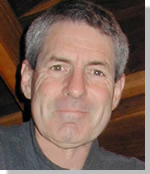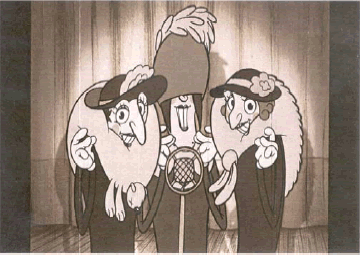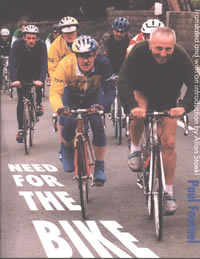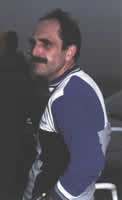 On The Road
On The Road
by: Bill Oetinger 5/1/2004
The French Confection
I'm in a French mood today! Come with me, as we teleport ourselves to Paris, or better yet to some sunny, sleepy village in Provence or the Haute-Loire, where the living is good and the cycling is breezy.
Clap on an old beret and cue up your vintage vinyl of Edith Piaf. Pull the cork on a nice, dry Cotes du Rhone; snag a fresh baguette, still warm from the oven, and a nice, soft wedge of Fromage d'Affinois...and settle down to enjoy this little journey abroad.
I don't often do reviews of books or movies. In fact, I have done neither in this venue before. So, to make up for lost time, I am going to do two reviews here...a two-scoop review...one of a movie and one of a book, both about cycling, and both quintessentially French.
The Triplets of Belleville
 The movie is The Triplets of Belleville, a feature-length animated film that came out last year. Some critics felt it should have won the Academy Award for best animated film of 2003, but it was edged out by Finding Nemo, another terrific film, which I also recommend.
The movie is The Triplets of Belleville, a feature-length animated film that came out last year. Some critics felt it should have won the Academy Award for best animated film of 2003, but it was edged out by Finding Nemo, another terrific film, which I also recommend.
The Triplets is the first feature film of 41-year old Sylvain Chomet, who was assisted along the way by a crew of French, Canadian, and Belgian artists of one sort or another, most notably Nicolas de Cracy, who was responsible for the lush, lovely backgrounds, and Bernard Charest, the man behind the whacky, catchy, magical sound track.
The film is a sensory overload for the eyes, and also for the ears. But behind all the exotic and fascinating imagery, there is a plot, and it's all tangled up with the world of bicycle racing, circa 1967 (my guess...they don't specify). Like all good bike races, the film begins with a prologue: a grainy newsreel clip of a jumping nightclub in the 20's, complete with caricatures of Josephine Baker, Django Reinhardt, Fred Astaire, and others. It's one of my favorite scenes in the movie...an hilarious and jazzy tribute not only to night life a la Parisienne in the no-holds-barred Roaring 20's, but also an homage to the loony cartoons of the period, especially the ones with the over-the-top caricatures of the Hollywood stars of the era.
The point of this zany scene is to set the stage for the triplets: a trio of fetching young sisters who do a red hot cabaret act. (Once you hear them sing their signature song, “Belleville Rendez-vous,” you won't be able to get it out of your head.) Now hold that thought about the triplets. We will meet them again, many years later.
End grainy newsreel; shift forward in time to the 50's, and meet Madame Souza, a short, stout, club-footed, Portuguese grandma, who has her little grandson Champion living with her. Madame Souza does her best to make little Champion happy, but nothing seems to work until she buys him a tricycle. Voila! Instant success! The boy is a born cyclist. He lives for nothing but making the wheels go round, and he keeps a box in his room of newspaper clippings from the accounts of the great struggles in the Tour de France.
Madame Souza realizes she has on her hands a boy who was born to bike, and as the film shifts forward in time again, to the 60's, we find the chubby little boy now grown into the archetype of a Tour racer: grotesquely bloated quads, tiny, ripped calves, and no upper body at all. We find him out training on his racing bike, with his implacable grandma riding along behind on his old trike...the personal trainer from hell.
All of that just lays the groundwork for the point where the plot really thickens...where a cabal of wicked French gangsters kidnaps Champion and other major Tour racers and spirits them away, across the ocean to the city of Belleville, a phantasm of towering skyscrapers and quasi-gothic embellishments. It's a fanciful melding of Quebec, Montreal, and Manhattan, as if New York had been settled by the French instead of the Dutch. Madame Souza, accompanied by her obese but lovalble bloodhound, Bruno, sets out in pursuit. She arrives in Belleville, temporarily at a loss as to what to do next. But she soon meets the triplets, former cabaret chanteusses and now somewhat elderly ladies, but still full of spunk and feisty mischief. The four grande dames join forces to unravel the mystery of where the bad guys have taken Champion. And that's enough plot for you! You'll have to see the film to find out how it all works out.
But the plot--as nutty as it is--is just the barest scaffold upon which to hang the dazzling animation. If you haven't seen the film, and you want to get a sampling of it, you can visit its official websiteand watch a trailer of the film or visit a gallery of stills. I warn you though: the stills don't do justice to the richness of the film's images. In stills, the visuals look flat and dull, rather like the original 101 Dalmations, for instance. But when the film is unfolding, it all comes to life and seems dense and chewy and wonderfully textured.
How have I come this far with my review without mentioning that you won't need to read subtitles for this foreign film? No, thank goodness, it isn't dubbed. The deal is: there is no dialogue. Hardly a line is spoken throughout the entire film. Everything is communicated with timing and expressions and gestures. In this sense, it pays tribute to the nearly silent films of France's comic genius, Jacques Tati, and also to goofball, sight gag French comedies like Zazie dans le Metro. All of it is just so....French! You begin to realize you're immersed in a world run by the sorts of people who could design and love a car as charmingly idiosyncratic as the Citroen Deux Chevaux...Futoroscope colliding with a medieval cathedral. It's totally appropriate to this film that all of the criminals drive stretch limos built on Deux Chevaux chassis, and if you think the idea of a 2CV as a limo is nuts, you've come a long way toward understanding the quirky charm of this movie.
It reminds me too of another of my all-time favorite French films: that dark, dank, whimsically cheery post-apocolyptic love story, Jean-Pierre Jeunet's Delicatessen. Both employ a dreamlike palette of moist, oil-slick colors, and layers upon layers of funky, antiquated texture enlivened by splashes of glistening, shimmering chrome and plastic...the resulting look ending up a sort of nuevo-retro, gothic kitsch.
But, you may be wondering by now, what about the cycling? Well, the cycling is there, throughout the film, lovingly articulated in so many scenes, large and small. There is gripping footage of the exhausted, heroic racers grinding slowly up a terrible, rock-ribbed alpine pass known as Col du Famur. Champion's bedroom is adorned with classic old race posters, including one for a 50's-era Paris-Brest-Paris. The underworld lair of the dastardly gangsters captures the smokey, gritty, hard-boiled world of six-day races. All of the cycling scenes express a great affection for the heritage of professional racing in the sport's spiritual home.
I only have one small quibble: I wish Champion, the bike racer, was a little more...well...animated! He appears to be constantly exhausted from his rigorous training regimen, or else he's doped to his glazed eyeballs. He seems semi-comatose throughout. I would have liked to see a little more humanity from him. After all, Madame Souza and his dog Bruno both love him. It would be nice to see a little reciprocal spark of love and affection in him as well.
In spite of that one little quibble, I will award this delightful work of art two thumbs up or four stars or a maillot jaune. Whatever signifies excellence, this film has it in spades. You might not have seen this film in your town, or it may have escaped your notice, as it mostly stayed in the art houses. If you can find it on the big screen, check it out there. If not, look for a DVD, which I believe is already available. If you have a halfway decent TV, you won't miss much in the transfer to the little screen. It will hold up okay. Plus, with your own copy, you can go back over and over it and deconstruct some of those lavish, lush backdrops. I'm sure there are images and visual puns and sight gags buried in there that will take several viewings to fully appreciate.
I plan to see it again in mid-May. Our local art house in Santa Rosa--the Rialto--is offering a one-night-only free viewing for anyone who will bicycle to the movie, and the Sonoma County Bicycle Coalition will be pitching in with secure, free valet bike parking for all the cycling cinema buffs. I plan to round up a few of my usual suspect friends to ride in to the showing, then home aftreward in the springtime dark, taillights twinkling like a glittery, glitzy special effect from the film.
Need for the Bike
 My book review is going to be a bit more difficult to write, because the book is a bit harder to describe. It is Need for the Bike (Besoin de velo) by Paul Fournel. It first came to my attention when one of my club mates, Al Bloom, submitted a review of the book to our club newsletter. I will begin my review by quoting the opening passage of Al's review: - This book is hard to categorize. Although it is written in prose, it has a strong poetic quality. While he touches often on Anquetil, Virenque, Merckx, and the rest, and describes passes of the Tour de France in loving detail, the author is not a racer and this is definitely not a book about racing. Rather, it is about what it means to be a cyclist, from the personal perspective of Paul Fournel.
My book review is going to be a bit more difficult to write, because the book is a bit harder to describe. It is Need for the Bike (Besoin de velo) by Paul Fournel. It first came to my attention when one of my club mates, Al Bloom, submitted a review of the book to our club newsletter. I will begin my review by quoting the opening passage of Al's review: - This book is hard to categorize. Although it is written in prose, it has a strong poetic quality. While he touches often on Anquetil, Virenque, Merckx, and the rest, and describes passes of the Tour de France in loving detail, the author is not a racer and this is definitely not a book about racing. Rather, it is about what it means to be a cyclist, from the personal perspective of Paul Fournel.
To understand the perspective of Paul Fournel, it may help to know a bit about him. He is currently 57 and is, by all accounts, a fairly exalted figure in the world of French letters, with many books, essays, and other works of literature in his palmares. At the time he wrote this book, he was the Cultural Attache at the French Embassy in Cairo. Like many of us, he has been a cyclist all of his life, but unlike most Americans, his cycling career has been overlaid and enriched by a lifelong romance with the great spectacle of bike racing in Europe. His father was a diehard racing fan, and Paul grew up avidly following the exploits of Anquetil, Charly Gaul, and Luison Bobet on their epic journeys up the cols and into the history books. Although, as Al notes, he is not a racer himself, he has spent a great deal of time riding with and getting to know many racers, up to the highest levels of the sport. His observations on cycling are informed by a deep affection for the rich tapestry of racing. He grew up near the town of Saint-Ãetienne in the cycling paradise of Haute-Loire, but now lives on the south coast, not far from the Camargue.
This is a small book. There are around 55 essays or vignettes, ranging in length from less than one page to several pages. They touch on every conceivable aspect of cycling, from crashing to eating; from racing to friendship; from the lovely scenery along the backroads to the little nagging injuries that torment riders; from the beauty of a classic frame to the qualities of asphalt. Think of any thought you have ever had about your involvement with your bike, and I can assure you that Fournel has had that thought too, and has elucidated that thought in a charming and compelling way, somewhere in this slim but meaty volume.
In fact, it was almost spooky for me to see how closely his observations and ruminations mirrored my own takes on any number of cycling topics. As you know--seeing as how you're reading this column--I too write about cycling and wander hither and thither across the vast map that is bikes and biking. (I have written about 55 essays for this BikeCal column so far...same as Fournel's total for this book.) Time after time, essay after essay, as I worked my way through his book, I was struck by how similar our comments were on a given subject.
For instance, you may recall a piece I wrote called ”A Question of Scale”, in which I suggested that some roads and landscapes were just too big and formless to be ideal for cycling. As Exhibit A, I offered you riding in Death Valley: But the landscape is so vast and open and uncluttered, and the roads are so flat and straight and unvarying in their aspect, that it can really mess with your head. You can sometimes see the road ahead of you for five miles, disappearing in the distance like an illustration of the principles of perspective and vanishing points. As you pedal along, you know you're moving forward, but nothing around you is changing. It feels as if you're on your rollers, churning away like mad and going nowhere. Although most of Fournel's cycling life has centered around France, he has travelled extensively and has lived and cycled in California. On page 95 of his book, he talks about cycling in Death Valley: “This sort of landscape is made to measure for the car. Lost in these immense straight lines, I felt like a displaced animal, a Sempe cartoon character who's too small for his surroundings, a miniscule trace of life in Death Valley.
It would not be surprising for us both to write about the elegant simplicity of a classic bike frame or about the vagaries of headwinds and tailwinds or about the things we smell along our rides. We both cover all the obvious topics. But both using Death Valley as our prime example in matching essays on the topic of scale? We both wrote about Hitchcock staging his film The Birds in Bodega Bay, which jumped out at me as another curious example of being on the same page in our cycling books of life. For what it's worth, we are both exactly the same age.
After awhile, these close confluences became so fascinating to me, I felt I had to introduce myself to this other writer about bikes with whom I seemed to share so many common threads. I sent an e-mail to him via his publisher, and he sent a cordial reply a few days later. Since then, we have established an interesting correspondence, ranging widely over the world of bikes and letters.
 I asked Fournel (left) if this book on cycling was typical of his literary efforts, or whether it was perhaps a divertimento from some other, more important work. I also wanted to know if he had written it as a single project or whether the essays had been written over time—as I do with mine--and then collected into one volume. Here is his reply:
I asked Fournel (left) if this book on cycling was typical of his literary efforts, or whether it was perhaps a divertimento from some other, more important work. I also wanted to know if he had written it as a single project or whether the essays had been written over time—as I do with mine--and then collected into one volume. Here is his reply:
“In fact this book is not so far away from what I write...same old boy. I wrote about sports (short stories, “Les athlètes dans leur têteâ€) that has been successfully staged this last fall in Paris by Andre Dussolier, a very well known French actor. I wrote about myself as a kid (“Le jour que je suis grandâ€), and I write about what I see and feel here or there. I just published a book about Cairo (“Poils de cairoteâ€) that gets very good reviews up to now. I would not say that this book is out of my usual tracks. I think it is one of my books. It rides on the main road. I like to transport literature into unusual fields. Why not biking?
"The bike book was written in one block, but I had been thinking about it for years. In fact, I wrote it out of frustration. I was in Cairo and unable to bike. I was just dreaming about cycling."
Somewhere in this column you will see reproduced the cover of the book. I thought it a rather curious cover photo...just a typical club ride, it appears. (I have found, in my own travels, that club rides are much the same, over there or over here: a hodge podge of friends and acquaitances, all brought together by a common love of riding.) One might have imagined the cover with a more glamorous, professionally staged photo of racers doing their thing or of some knock-out alpine scenery. But that's not what the book is about, really. I asked Paul about the photo...
"The guy on the cover is a friend of mine. His name is Jacques Plaine and he is a former bookseller. He now runs the Fête du livre in Saint-Ãutienne (my home town). Others behind him are good riders from the area. The girl (you can hardly guess it is a girl since she wears a helmet) is one of the best French lady-riders (she is in the top 20). The guy is her Daddy and he used to race. Nothing like a pro. That photo was taken during the “montée des soleils de l'automne†which is the riding part of the Fête du livre.†I asked what a bike ride was doing associated with a book festival and he replied, "We bike there because we like biking! This has nothing to do with the book festival apart from the fact that we gather people in the book bizness who like to ride!"
I am tempted to quote numerous different passages from the book to show how well Fournel puts things, and to illustrate the broad range of his observations. But I would rather allow you to have the pleasure of discovering his words and meditations first-hand, on your own. Besides, no selected sampling of his thoughts can do justice to the scope of his writing on this best of all possible subjects.
Take my word for it: if you love cycling--from the thrills of racing to the quieter joys of touring--this book will speak to you. You will find yourself somewhere on the road with Paul, laughing at his gaffes, moaning in sympathy at his suffering--which is our suffering--and smiling in complicity at all those fundamental truths that anyone who rides a bike comes to understand and appreciate. He has the good writer's knack of stating the obvious in ways that makes it fresh and revelatory, all over again.
Need for the Bike is available at Amazon.com
Bill can be reached at srccride@sonic.net

